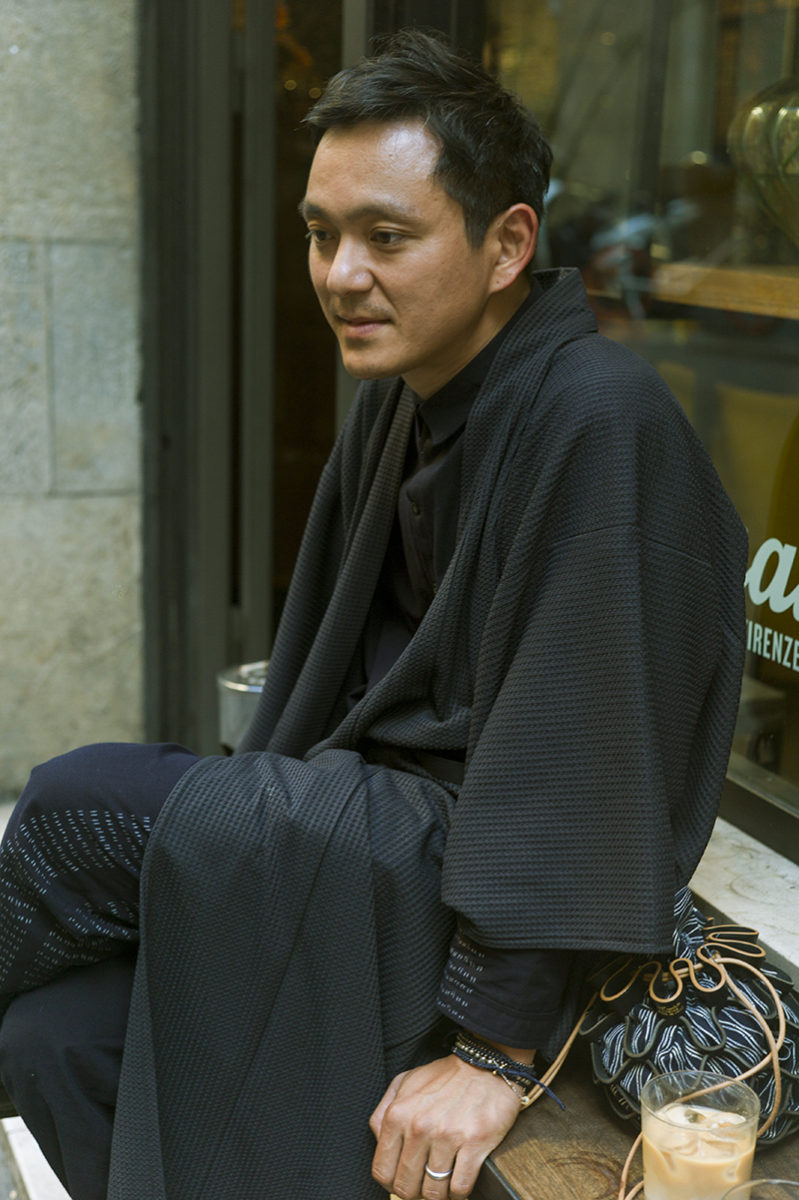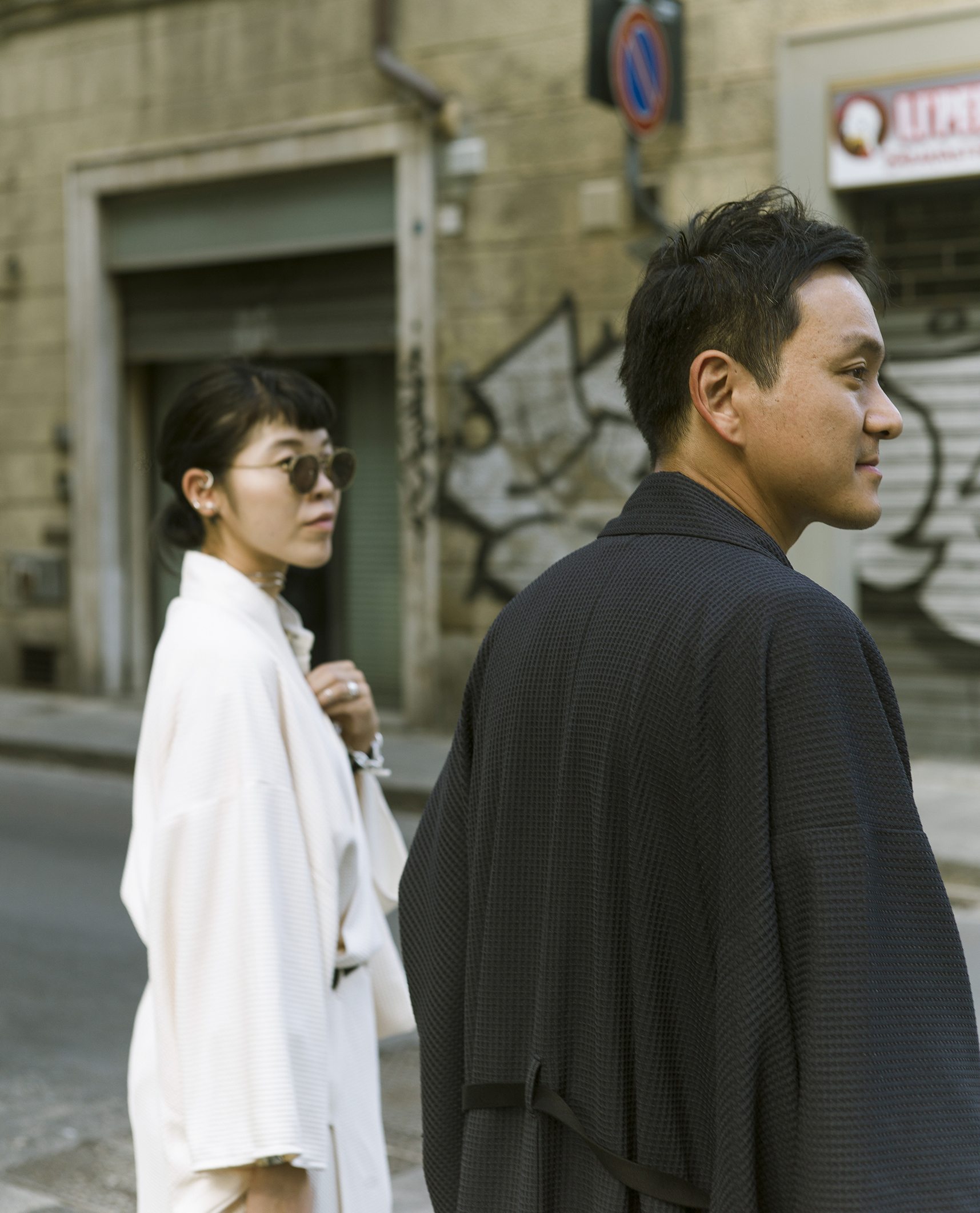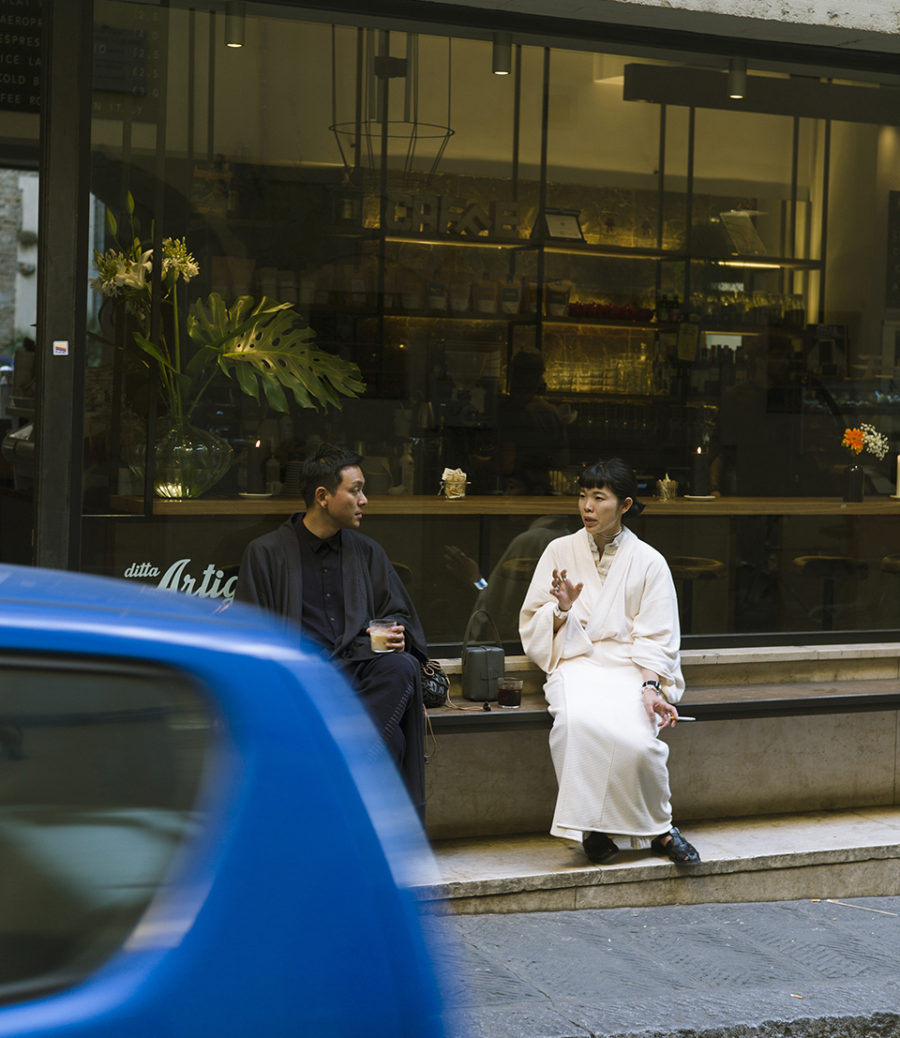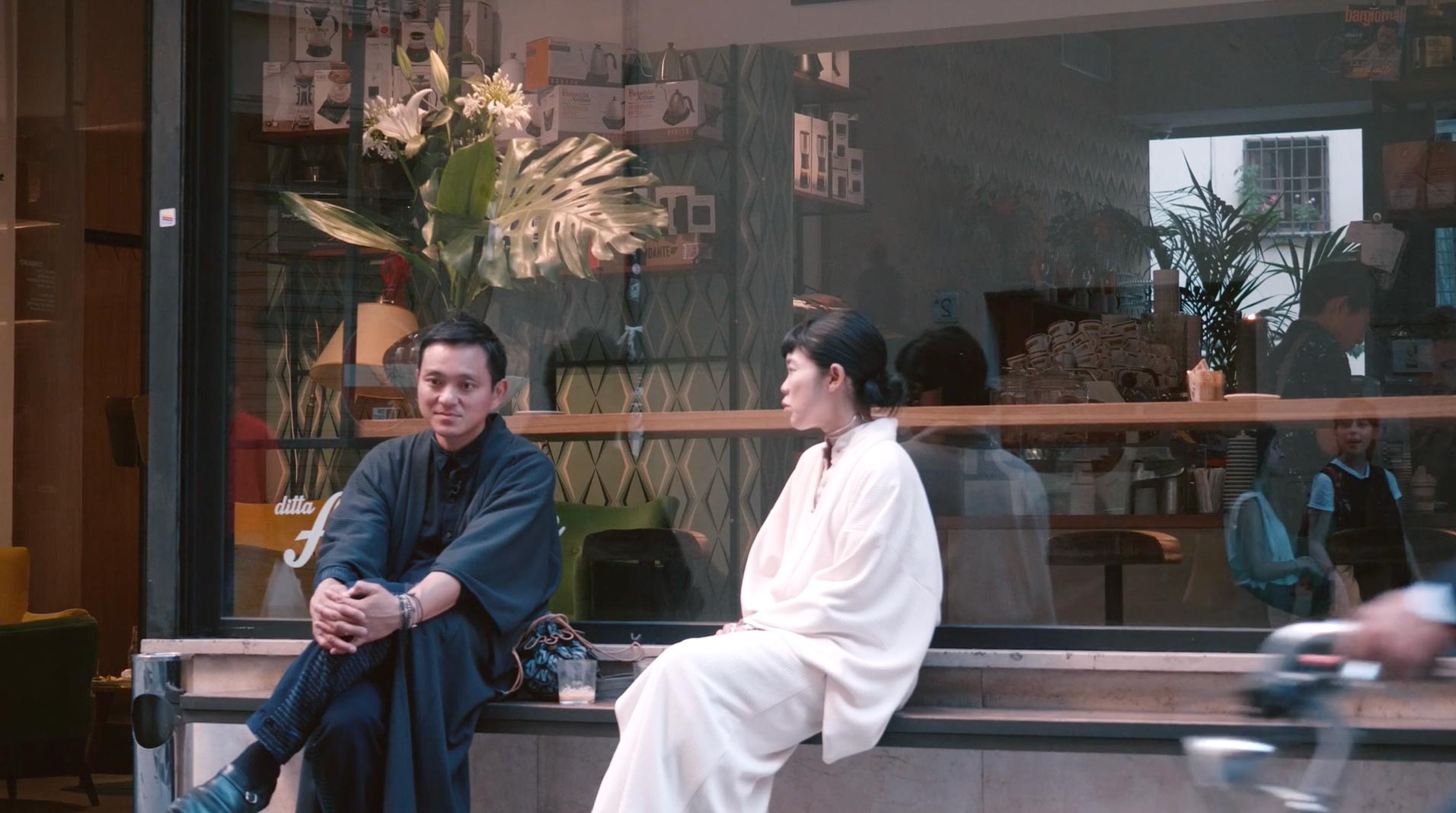A new relation between kimono and the outdoorsKIMONOASOBI【Part 1】
Play outdoors in a kimono. “OUTDOOR KIMONO”
developed out of a desire to
update a uniquely Japanese culture.
FIELDWORK is a site for not only future Snow Peak Apparel staff, but also Snow Peak customers and everyone else involved to do “field work” together. Snow Peak’s mission statement is: “To constantly change, innovate, and change the times.” OUTDOOR KIMONO was born out of a meeting of minds between Snow Peak and Yamato director Takayuki Yajima, who wants “to update culture.” We asked Mr. Yajima and Snow Peak Corporate Officer and General Manager of Planning and Development Lisa Yamai to discuss the meaning of their collaboration.
Doing what’s uniquely possible in Japan and disseminating it overseas
- Takayuki Yajima
- When we first met, you said you wanted to make the blueprint of Japanese outdoor products through OUTDOOR KIMONO. It all started with music festivals. The first catalyst was me feeling that the kimono needs a better hook and thinking that it might be interesting to wear yukata [a casual summer kimono] at Japanese music festivals in the summer before I met you.People of my father’s generation were quite Americanized and had aggressively brought American culture into Japan. With our generation, we’re living in a time when we want to do the things we can do well and disseminate it abroad rather than releasing Americanized products in Japan. Music festivals came from overseas, but I thought it might be made into a more uniquely Japanese entertainment if people wore yukata to them. I approached some outdoor festivals but was ignored. Goddamn it, I thought, but then I also considered that people who go to these festivals also camp and thought it might be interesting to making kimono and yukata that you could wear outdoors.
- Lisa Yamai
- I’m also the type to question things, so ever since I began doing apparel, I’d been asking fundamentally what a Japanese outdoor products manufacturer could uniquely contribute. There are very few Japanese outdoor products manufacturers and in terms of brands in the industry, there’s basically Snow Peak and mont-bell. There’s Goldwin, but their main business is licensing other brands such as The North Face. So Japanese outdoor fashion is quite Americanized. And there’s of course also the pressure of sales. We have to sell clothes to put food on the table after all. I’d started having showrooms overseas, but I was still concerned about what we should be doing, discreetly making noragi [farm clothes] and things. It was around then that I met you and I was moved by your passion for kimono-making. I was very impressed by the fact that you make kimonos with a great respect for Japanese sartorial culture. We had a couple meetings after we met. The initial idea was to make kimono with outdoor fabrics, but Snow Peak’s camping style was already uniquely Japanese.
- Yajima
- Yes, that resonated strongly with me. Making something uniquely Japanese that hasn't been done overseas.
- Lisa
- If the two companies are going to collaborate, I wanted to do something we absolutely could not do alone. There was a good chemical reaction, don’t you think?


I wanted to work with Snow Peak,
because it makes fashion,
but not products for consumption.
We won’t make “fashion” designed exclusively for consumption
- Yajima
- There are other outdoor product brands, but seeing Snow Peak’s apparel products, I knew I wanted to collaborate with the brand. I’d read your articles as well. I imagined you’d be interesting. You make fashion, but not products for consumption. “Fashion” is a convenient word, isn't it? I try not to use it. It’s commonplace to say, “We want people to wear kimono as fashion,” but I thought you’d be conscious of the nuance of consumption on the other side of fashion. That’s why I wanted to work with you.
- Lisa
- I also think that we should have consumers buy things only after they understand the essence or value of things and how they form the background of a brand or company. When I first participated in a showroom in New York after launching Snow Peal Apparel, no major selected multi-brand shops would give me the time. What the hell, I’d thought, and simultaneously realized how vapid trend-chasing fashion is. When we showed in New York, and this is both the good and bad thing about Americans, but they made judgements based on what they saw, and not whether we’re known. Of course it’s a capitalist society, so you have to couple with mass media and do some heavy marketing to achieve quick sales and things like that. The buyers, though, simply look at the products and make their decisions. And once I’d found retailers in America, suddenly Japanese shops started buying our products. As a result, it worked, but it was crucial that I harbored no illusions to start with. I could face reality head on.
- Yajima
- I think you're right that fashion is vapid.

Yamato CEO Takayuki Yajima. “OUTDOOR KIMONO” was born out of the meeting of minds with shared values regarding management and manufacturing.

Updating culture
- Yajima
- There was another simple reason for wanting to do something in the overseas market. When you get into the real world of Japanese clothes, it’s actually complicated, but kimono is an extremely simple clothing. It’s linear and sewn very simply. The first piece of clothing was a piece of fabric cut linearly and wrapped around the body. When I realized that, I thought kimono might be the world’s oldest ethnic clothing. The Indian saree might be another, but there’s something very primitive about blind stitching fabric. Overseas, even ethnic clothes are cut on curvilinear patterns, but in the beginning I think humans wore fabric cut linearly. So at showrooms abroad, people say they want to try on the OUTDOOR KIMONO and it looks great on them. Maybe this is how things were when fabrics were blind stitched a long time ago. We showed OUTDOOR KIMONO at Pitti in Italy and we got great responses. When people feel that they can, surprisingly, quite easily wear the non-traditional, updated kimono, the kimono can be disseminated overseas. OUTDOOR KIMONO also has a significance in the world of kimono. It can be worn easily and daily. It eradicates the old fashioned and stuffy image of the kimono. That’s my hope for OUTDOOR KIMONO anyway.
- Lisa
- I think that probably from now on, it’s not going to work to simply lean on one side or the other. It's going to be important to break through in another direction. In terms of doing something new, not necessarily with kimono, collaborations have become a marketing tool, like with Louis Vuitton and Supreme.
- Yajima
- Right, simply collaborating to make sales. I don’t like that either.
- Lisa
- I really felt that it would be possible to create truly new value by collaborating with Yamato Kimono.
- Yajima
- It's especially true of kimono, but we often hear the “sound” argument that culture should be protected. Really, however, culture needs to be cultivated. This is kind of a critique of the kimono industry but I really dislike the idea that things need to be protected because it’s culture or because it’s handmade. They need to be updated, not protected.
- Lisa
- In the end, what needs to stay will survive and what doesn’t will wither away.
- Yajima
- Right, so if you want culture to survive, you have to update it to match the times. Everyone’s defending themselves with this weird shield of protectionism. That’s the problem with the kimono industry.
- Lisa
- They hide behind “sound” arguments until the culture’s been lost altogether because of them.
photography : Ko Tsuchiya
Edit : Kei Sato


